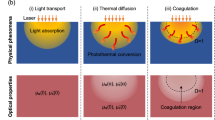Abstract
An analytical model to predict the temperature distribution and ablation depth in excimer laser ablation process by solving one-dimensional heat conduction equation has been proposed. The model takes into account aspects like temperature dependent thermal properties for polycarbonate material and re-solidification during pulse off-time. The effects of fluence and number of pulses with and without consideration to the temperature dependent thermal conductivity and pulse delay have been investigated. It is observed that consideration to temperature dependent thermal conductivity and re-solidification during pulse ‘off-time’ results in an appreciable improvement in the accuracy of ablation depth prediction and the error being within ± 0.8 μm.
Similar content being viewed by others
Abbreviations
- λ l :
-
Thermal diffusivity of liquid region, m2/s
- λ s :
-
Thermal diffusivity of solid region, m2/s
- k s :
-
Thermal conductivity of solid region, W/mK
- k l :
-
Thermal conductivity of liquid region, W/mK
- A s :
-
Aborptivity of solid region
- A l :
-
Aborptivity of liquid region
- R:
-
Reflectivity
- L :
-
Latent heat, cal/g
- T m :
-
Melting temperature of substrate, K
- T v :
-
Vaporization temperature of substrate, K
- T o :
-
Ambient temperature, K
- ρ s :
-
Density of solid region, kg/m3
- ρ l :
-
Density of liquid region, kg/m3
- S (t) :
-
Position of interface between solid and liquid regions
- δ l(t) :
-
Temperature penetration depth in liquid region
- δ s(t) :
-
Temperature penetration depth in solid region
- T w (t) :
-
Temperature at the surface, K
- I :
-
Laser intensity, W/m2
- t m :
-
Time required to reach melting temperature, s
- c ps :
-
Specific heat of solid region, J/kg K
- c pl :
-
Specific heat of Liquid region, J/kg K
- x i :
-
Shift in interface location
References
Li, K. and O’Neil, W., “Fibre laser microvia drilling and ablation of Si with tuneable pulse shapes,” Int. J. Precis. Eng. Manuf., Vol. 13, No. 5, pp. 641–648, 2012.
Kim, G. D., Rundel, J. T., and Paul, B. K., “UV laser ablation of polyetherimide embossing tools for the packaging of membranes and microchannels using sealing bosses,” Int. J. Precis. Eng. Manuf., Vol. 11, No. 5, pp. 665–671, 2010.
Oh, K. H., Lim, H., Im, H., and Jeong, S., “Manufacturing process of copper microgrooves utilizing a novel optical fiber-based laser-induced etching technique,” Int. J. Precis. Eng. Manuf., Vol. 10, No. 3, pp. 155–160, 2009.
Saxena, I., Agarwal, A., and Joshi, S. S., “Fabrication of microfilters using excimer laser micromachining and testing of pressure drop,” Journal of Micromechanics and Microengineering, Vol. 19, No. 2, Paper No. 025025, 2009.
Pecholt, B. and Molian, P., “Nanoindentation of laser micromachined 3C-SiC thin film micro-cantilevers,” Materials and Design, Vol. 32, No. 6, pp. 3414–3420, 2011.
Sun, S., “Fabrication Technology of Involute Micro Gear Based on Two-Photon of Femtosecond Laser,” Applied Mechanics and Materials, Vol. 44–47, pp. 670–674, 2011.
Zhang, W., Yao, Y. L., and Chen, K., “Modeling and Analysis of UV Laser micromachining of Copper,” International Journal of Advanced Manufacturing Technology, Vol. 18, pp. 323–331, 2001.
Ho, J. R. and Grigoropoulos, C. P., “Gas dynamics and radiation heat transfer in the vapor plume produced by pulsed laser irradiation of aluminum,” Journal of Applied Physics, Vol. 79, pp. 7205–7215, 1996.
Paterson, C., “Excimer laser ablation of microstructures: A numerical model,” Journal of Applied Physics, Vol. 86, pp. 6538–6545, 1999.
Dutto, C., “Numerical and experimental analysis of pulsed excimer laser processing of silicon carbide,” Applied Surface Science, Vol. 184, pp. 362–366, 2001.
Schmidt, H., Ihlemann, J., Wolff-Rottke, B., Luther, K., and Troe, J., “Ultraviolet laser ablation of polymers: spot size, pulse duration, and plume attenuation effects explained,” Journal of Applied Physics, Vol. 83, pp. 5458–5468, 1998.
Kar, A. and Mazumdar, J., “Mathematical Model for laser ablation to generate nanoscale and submicrometer size particles,” Physical Review E, Vol. 49, pp. 410–419, 1994.
Gordon, P., Balogh, B., and Sinkovics, B., “Thermal Simulation of UV laser ablation of polyimide,” Microelectronics Reliablity, Vol. 47, No. 2–3, pp. 347–353, 2007.
Conde, J. C., Lusquiños, F., González, P., Serra, J., León, B., Guido, D., and Perrone, A., “Laser ablation of silicon and copper targets: Experimental and finite element studies,” Applied Physics A, Vol. A-79, pp. 1105–1110, 2004.
Vasantgadkar, N. A., Bhandarkar, U. V., and Joshi, S. S., “A finite element model to predict ablation depth in pulsed laser ablation,” Thin Solid Films, Vol. 519, pp. 1421–1430, 2010.
Marla, D., Bhandarkar, U. V., and Joshi, S. S., “Critical assessment of the issues in the modeling of ablation and plasma expansion in pulsed laser deposition of metals,” Journal of Applied Physics, Vol. 109, No. 2, Paper No. 021101, 2011.
Rohsenow, W. M., Hartnett, J. P., and Ganic, E. N., “Handbook of heat transfer fundamentals,” McGraw Hill, New York, 1985.
Jiji, L. M., “Heat conduction,” Jaico Publication House, Mumbai, 2003.
Zhang, X. and Fujii, M., “Measurements of thermal conductivity and thermal diffusivity of polymers,” Polymer Engineering and Science, Vol. 43, No. 11, pp. 1755–1764, 2000.
Osswald, T. A. and Menges, G., “Materials Science of Polymers for Engineers,” 2nd Edition, Carl Hanser Verlag, Munich, 2003.
Jin, X., Li, L., and Zhang, Y., “A study of Fresnel absorption and reflections in the key hole in deep penetration laser welding,” Journal of Physics D: Applied Physics, Vol. 35, No. 18, Paper No. 2304, 2002.
Author information
Authors and Affiliations
Corresponding author
Rights and permissions
About this article
Cite this article
Marla, D., Barde, V. & Joshi, S.S. Analytical model to predict temperature distribution and ablation depth in excimer laser micromachining. Int. J. Precis. Eng. Manuf. 14, 29–36 (2013). https://doi.org/10.1007/s12541-013-0005-2
Received:
Accepted:
Published:
Issue Date:
DOI: https://doi.org/10.1007/s12541-013-0005-2




